Best bikepacking bags 2023: A buyer's guide for multi-day adventures
We share the best bikepacking bags for multi-day adventures and how to choose the best for you
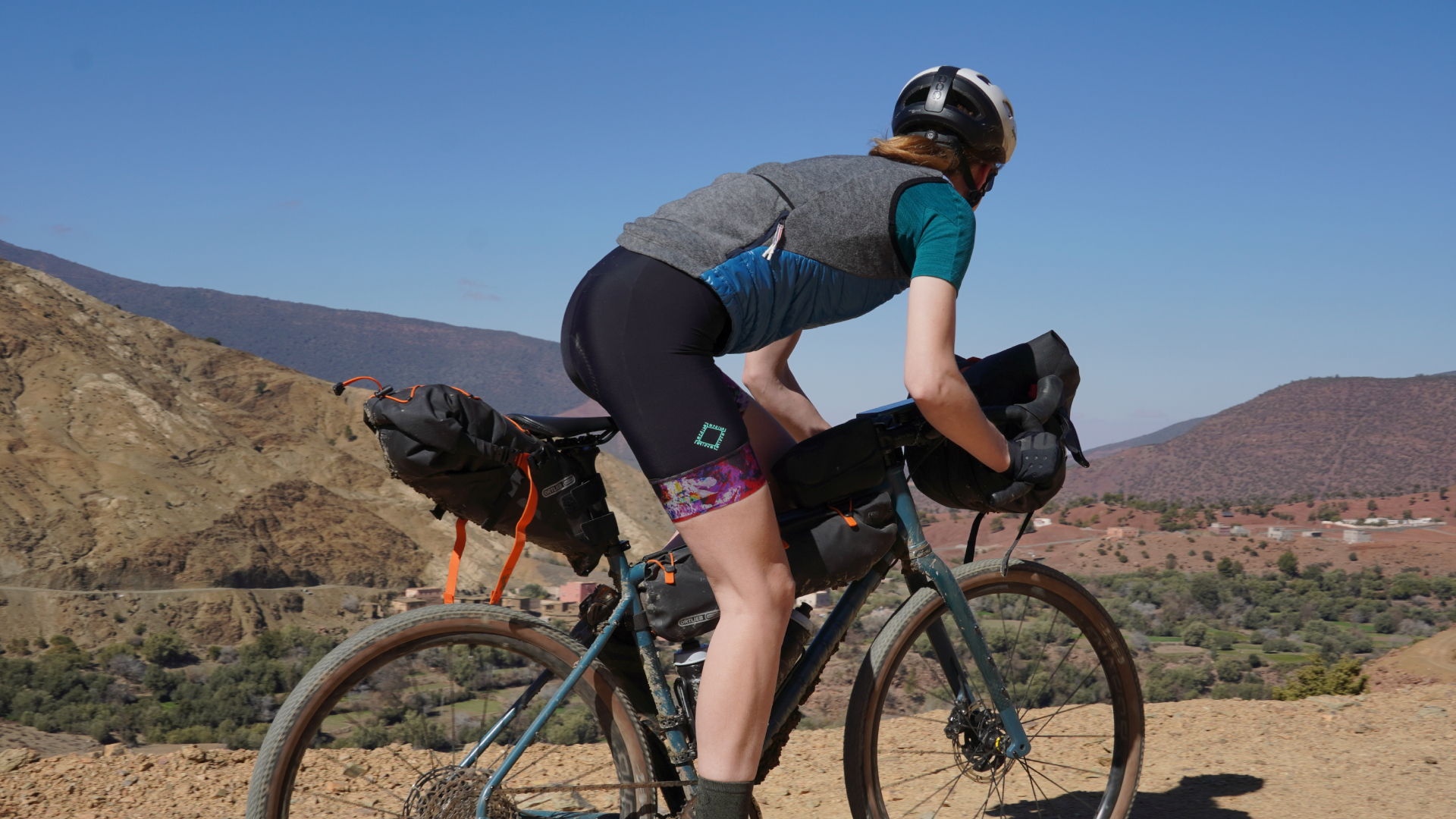
- The quick list
- SADDLE PACKS
- 1. Best for large loads
- 2. Best for small loads
- 3. Best for heavy loads
- 4. Easiest to use
- HANDLEBAR BAGS
- 5. Best bar bag
- 6. Most versatile
- 7. Best for bulk
- 8. Best for volume
- TOP TUBE BAGS
- 9. Most streamlined
- 10. Best small bag
- 11. Easiest access
- FRAME BAGS
- 12. Most serious
- 13. Most durable
- BACKPACKS
- How to choose
- How we test

The list in brief ↴
Saddle packs
1. Best for large loads
2. Best for small loads
3. Best for heavy loads
4. Easiest to use
Handlebar bags
5. Best bar bag
6. Most versatile
7. Best for bulk
8. Best for volume
Top tube bags
9. Most streamlined
10. Best small bag
11. Easiest access
Frame bags
12. Most serious
13. Most durable
How to choose
How we test
The best bikepacking bags will let you travel light on your bike while still carrying all the luggage you need for a multi-day trip. While bicycle touring is a long-established pursuit, bikepacking is far newer.
Certainly, its roots are to be found in traditional touring and Audaxing, but whereas touring usually means a specialist touring bike designed for stability and mounting points for a rack and panniers, most of the best bikepacking bags can be attached directly to the bike's frame, giving you much more flexibility in what you ride and where you can go.
The resurgence in self-supported bike racing on both road and mountain bikes coupled with the interest in all things gravel has led to greater exploration of multi-day rides that piece together both on and off-road sections, all in the pursuit of fun and adventure.
Today it appears that bikepacking could well be on its way to becoming as firmly rooted in cycling culture as traditional touring - and the development of specific bikepacking bags that don’t require pannier racks has certainly aided its growth.
Coupled with the best bikes for bikepacking, these lightweight bikepacking bags, mounted to the frame, handlebars and seatpost, allow you to carry varying loads on both roads and trails. This makes them adaptable for a range of self-supported trips, from mini-adventures to ultra-endurance events and more.
We've got loads of bikepacking advice on the website - check out our bikepacking guide that contains everything you need to know to get started and our bikepacking kit list with absolutely everything you need to go bikepacking.
There's a whole array of clothing designed to help you squeeze in that bit more, like the best cargo bib shorts, with pockets for an extra energy gel or bar. And our guides to the best gravel and adventure bikes and the best touring bikes will help you select the perfect steed for your next bikepacking adventure.
Whether you're planning on a quick over-nighter equipped with little more than a camping stove and a bivvy bag or a trip of a longer duration, we've found the best bikepacking bags and multi-day bike bags on the market. And If you’re new to bikepacking, at the bottom of the page our buyer's guide gives you more detail on all of the things to consider when buying bike luggage.
The quick list
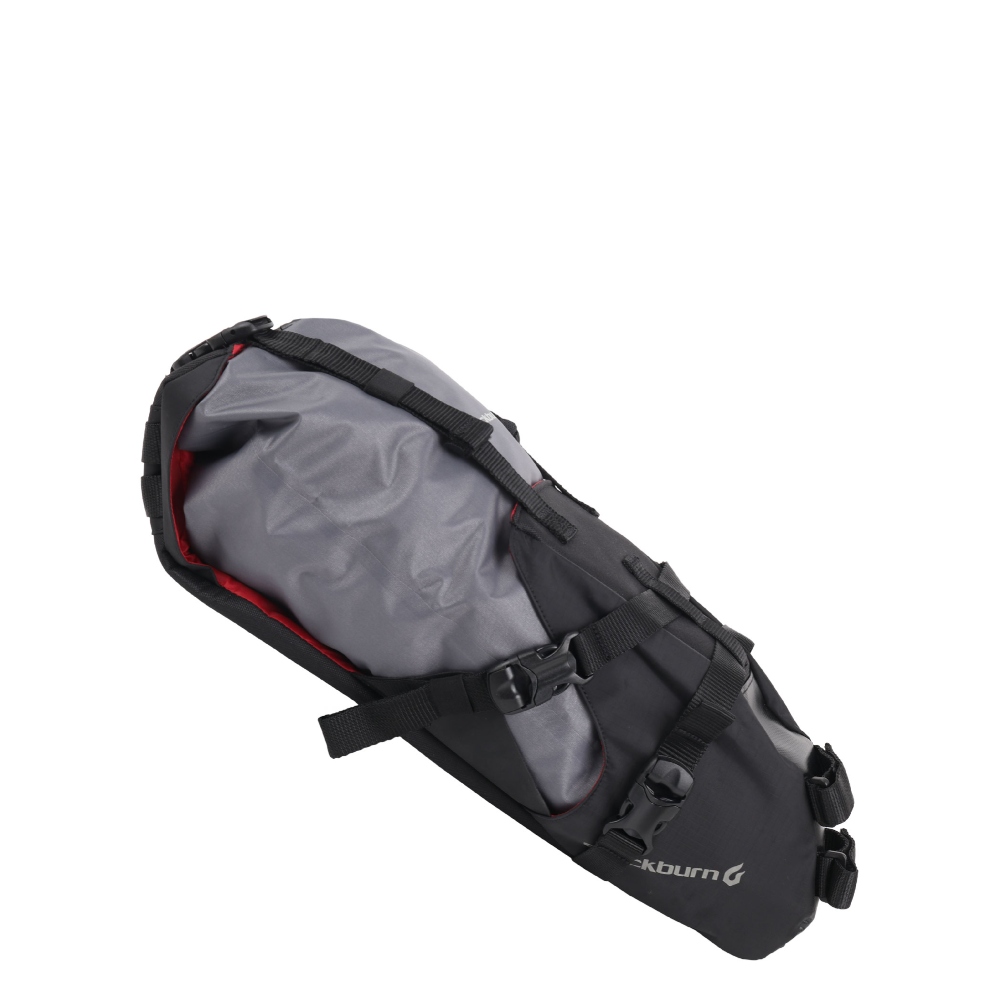
Best for large loads
11 liters is a lot of carrying capacity, and the waterproof Blackburn Outpost does its job very well. The roll-top design is easy to use and attaching it to the bike is very simple. It did catch the tester's legs a little though, so check your saddle/leg/bag combo.
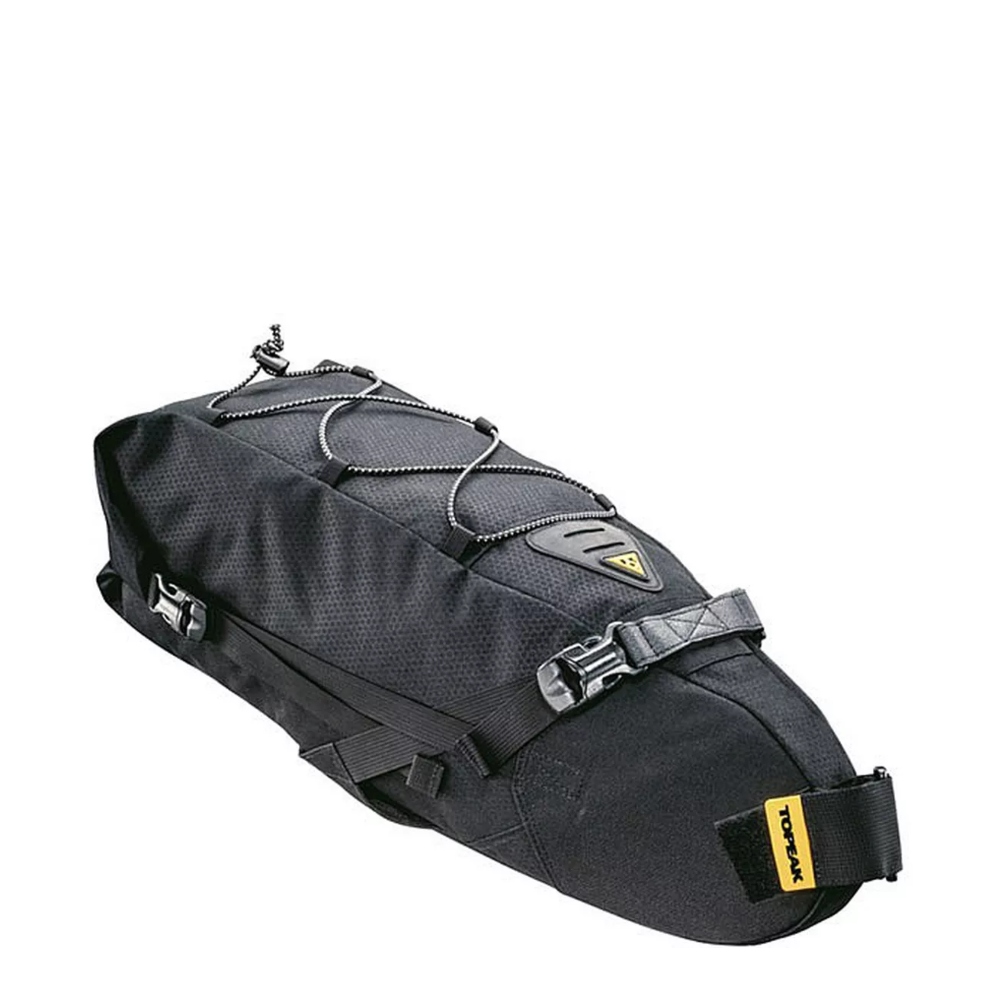
Easiest to use
Available in 3 sizes, the Topeak Backloader features waterproof fabric whilst an air purge valve and compression straps reduce its bulk and stabilise the load. Pricing is good although the bag is a little heavier than some on the market.

Best bar bag
With a 10-liter capacity and a roll-top closure, Restrap's Bar Pack is perfect for larger loads. There is a smaller compartment to separate the cargo and allow access to some items on the go whilst the waterproof fabric kept everything dry.
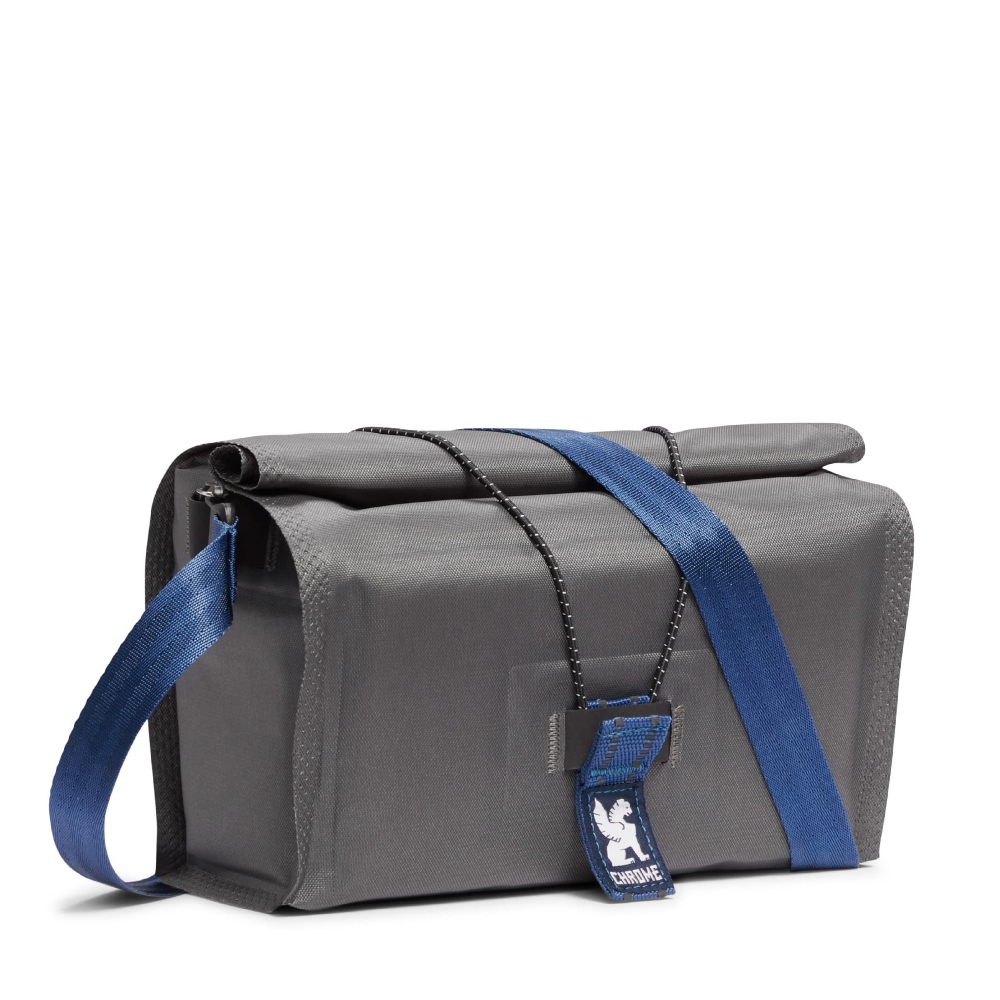
Most versatile bar bag
Whether used for long trips or commuting, on or off the bike, Chrome's Urban EX bar bag ticked a lot of boxes. The roll-top closure was easy and secure to use, the tough fabric proved durable and the included shoulder strap added extra convenience.
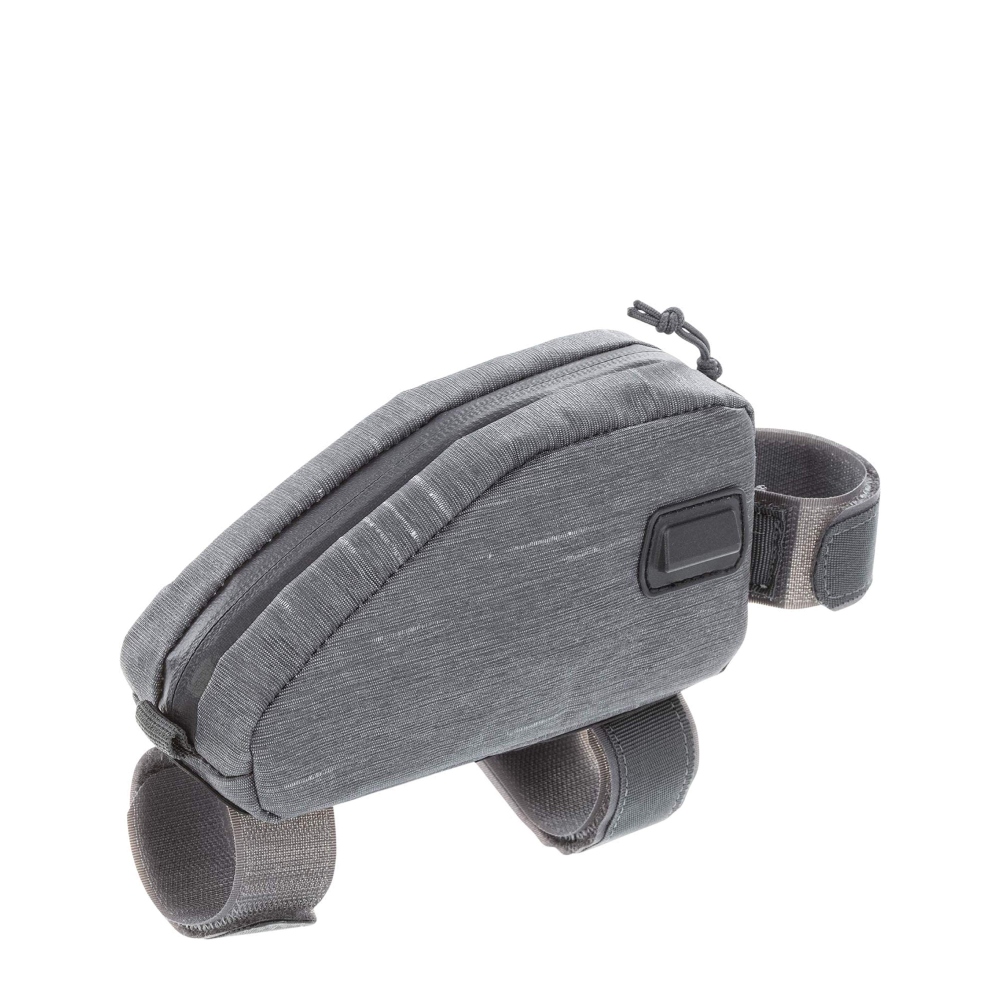
Best small bag
Evoc's Top Tube Pack might only have a 0.5 liter capacity, but the bag's rigid sides and waterproof zip keep the contents secure and stable. Attachment is simple, with just 3 Velcro straps and the addition of a cable port is a nice touch for keeping any handlebar tech charged up.
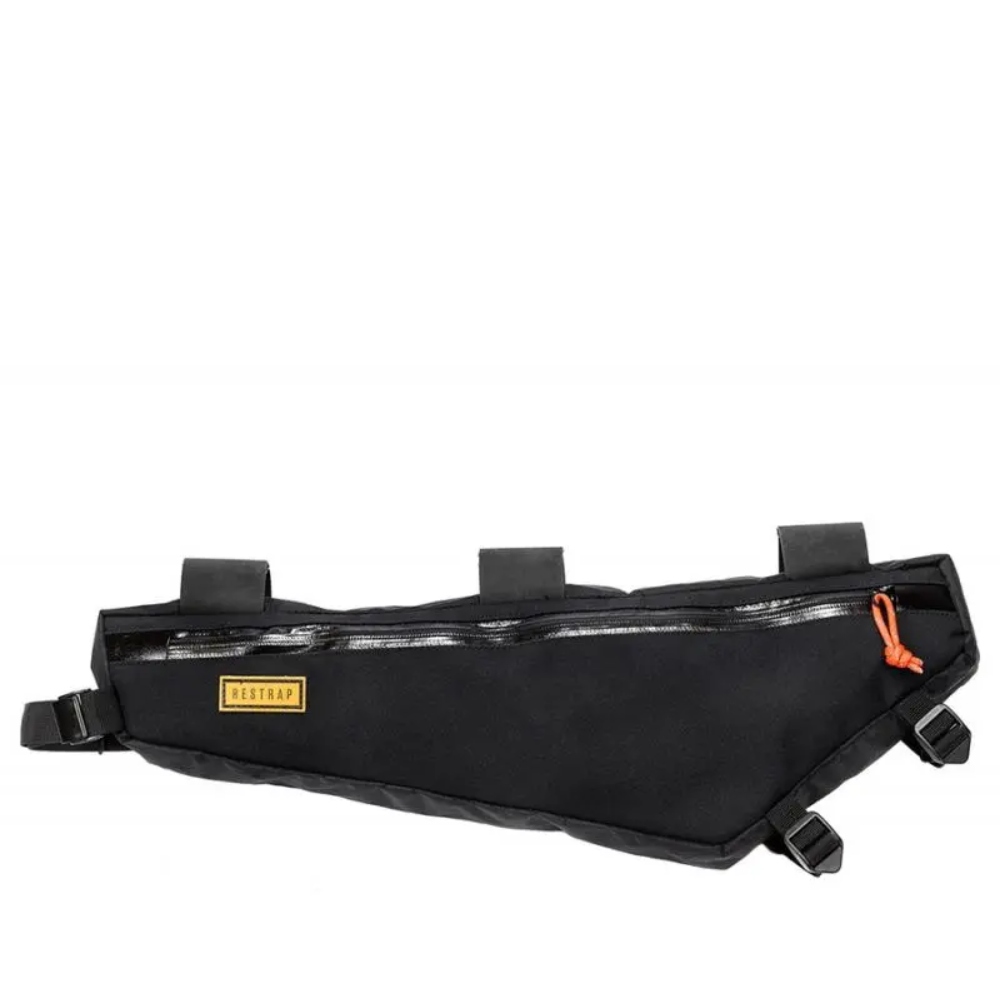
Best for serious bikepackers
The 5 Velcro straps used to secure Restrap's frame bag hold it very securely, and meant that it didn't sway or wobble at all. There is access to the 4.5 liter capacity from either side and a divider to help organization whilst the bag is virtually waterproof save for the handy cable port hole.
Best bikepacking bags
Saddle packs
Best bikepacking seat pack for carrying large loads
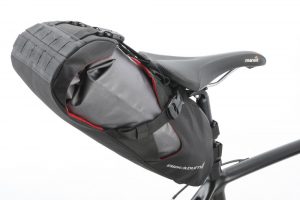
Specifications
Reasons to buy
Reasons to avoid
The Blackburn Outpost seat pack is a clever solution to add a lot of capacity and flexibility without bolting anything onto your bike. The bag itself is a roll-top dry sack and sits in a separate carrier that attaches to your bike, so it's easy to remove the bag for access in camp.
However, it does recommend not attaching to a carbon seat post (but we have in the past). It provides a great level of waterproofing, and its position does act as a bit of an ass-saver, but the extra weight up high does take a bit of getting used to.
The Velcro attachment straps were unfortunately noticeable on the back of the legs when pedalling, something worth considering if you're planning on being in the saddle for multiple days.
Read more: Blackburn Outpost seat pack full review
Best bikepacking seat pack for smaller loads
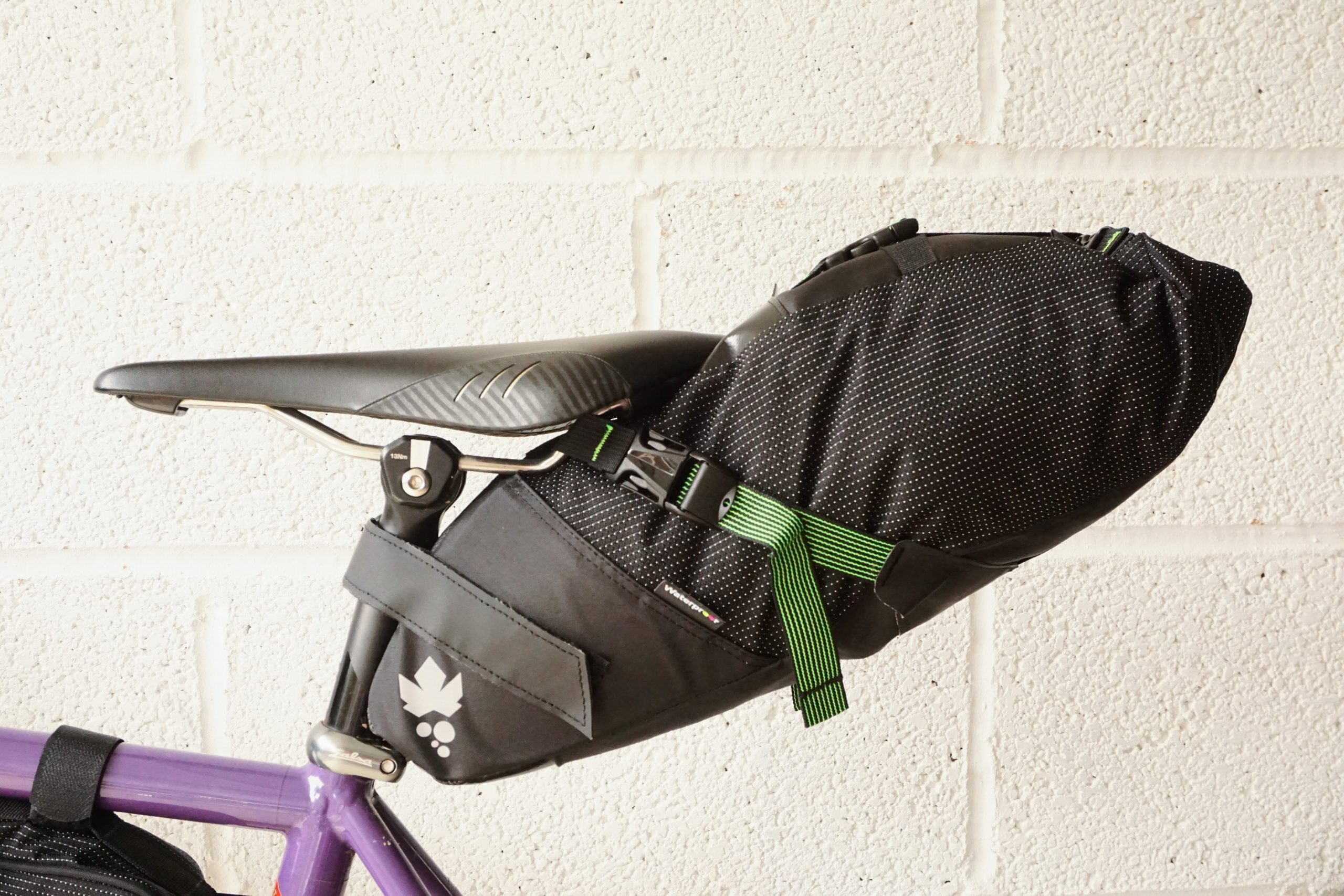
Specifications
Reasons to buy
Reasons to avoid
The Cluster bag is the smallest of Italian brand Miss Grape's seat post bags at 7 liters, which means that it works well for shorter seatpost lengths and shorter trips, although webbing loops on top allow stowage of extra items outside the main compartment. The rubber straps help to prevent damage to the bike and ensure a stable fit.
The roll-down top ensures water resistance, which we tested in a storm. Loaded up, the bag can sag a little, although it avoids sway and doesn't rub against the thighs as you pedal.
Read more: Miss Grape Cluster 7 seat pack full review
Best bikepacking seat pack for heavy loads
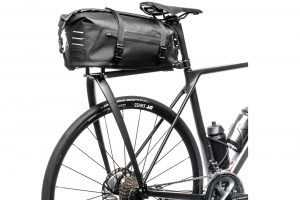
Specifications
Reasons to buy
Reasons to avoid
There are several rear bikepacking Tailfin setups, all of which will require the Tailfin rack system. The whole setup with carbon option will set you back over £300 / $400, although there is an alloy rack version that is £70 / $90 cheaper, but a couple of hundred grams more in weight (but you do gain three extra mounts for the ability to add other bottle cages or luggage).
The frame-mounted system boasts to be quick release unlike traditional racks, coming free in a claimed 30 seconds, with either QR or thru-axle compatibility. The seatpost connection is secure and kind to carbon frames and is designed to wrap around any size or shape of seatpost, including deep aero.
The total maximum load for the racking system is a substantial 9kg. With two Transcontinental Races under its belt, the fully waterproof system has won plenty of fans. On test, we found the system to be ace, with the design simplicity and ease of use making you forget the price on the first ride.
Read more: Tailfin Aeropack S Rigid Seat Pack full review
Best bikepacking seat pack for ease of use
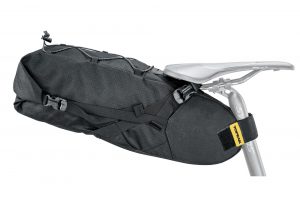
4. Topeak Backloader Bag
Specifications
Reasons to buy
Reasons to avoid
The Backloader from Topeak has been specifically designed for bikepacking as a streamlined way of carrying gear. It is constructed using what Topeak says is a lightweight, highly water-resistant and durable fabric.
The pack has compression straps to help condense its waistline, which should reduce the pendulum effect, and a built-in air release button helps reduce the inner bag further. Available in 6, 10 or 15-liter options, it uses both clips and a Velcro mounting system attached to the saddle rails and seat post.
Handlebar bags
Best bikepacking handlebar bag on test
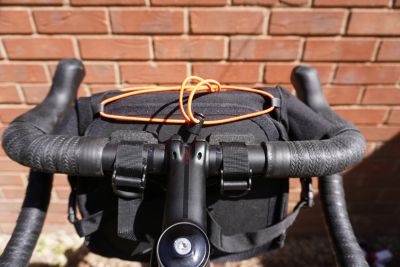
Specifications
Reasons to buy
Reasons to avoid
Restrap's 10-liter Bar Pack is made from durable, waterproof nylon. It has an easy-to-use roll-top that's closed using two buckles, with this main compartment complemented by a smaller secondary compartment that uses a Velcro closure. Essentially this means that you can still access items while on the go. On test we loved this combination, with the roll-top being a real winner.
The bag's generous 10L capacity allowed us to carry all we'd want to in a bar bag, with the compression straps doing a neat job of keeping everything in place. The additional details of both a D-lock holder and bungee webbing only added to the Bar Pack's functionality and appeal.
Read more: Restrap Bar Pack full review
Best bikepacking handlebar bag for versatility
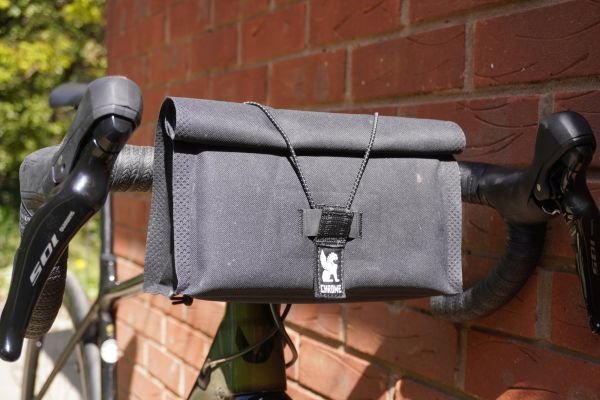
Specifications
Reasons to buy
Reasons to avoid
The Chrome Urban Ex is both well-designed and well-made. The roll-top closure makes it easy to access your gear and is suitably robust. Likewise, the rest of the bag feels equally durable, with a tough waterproof fabric on the bag's exterior and a decent level of padding on the inside of the bag. Its smaller size means that it's great for everyday use while still being practical for longer trips. The inclusion of a shoulder strap only helps to increase the bag's versatility.
Read more: Chrome Urban Ex Handlebar Bag 2.0 full review
Best bikepacking handlebar bag for easy carrying of bulky kit
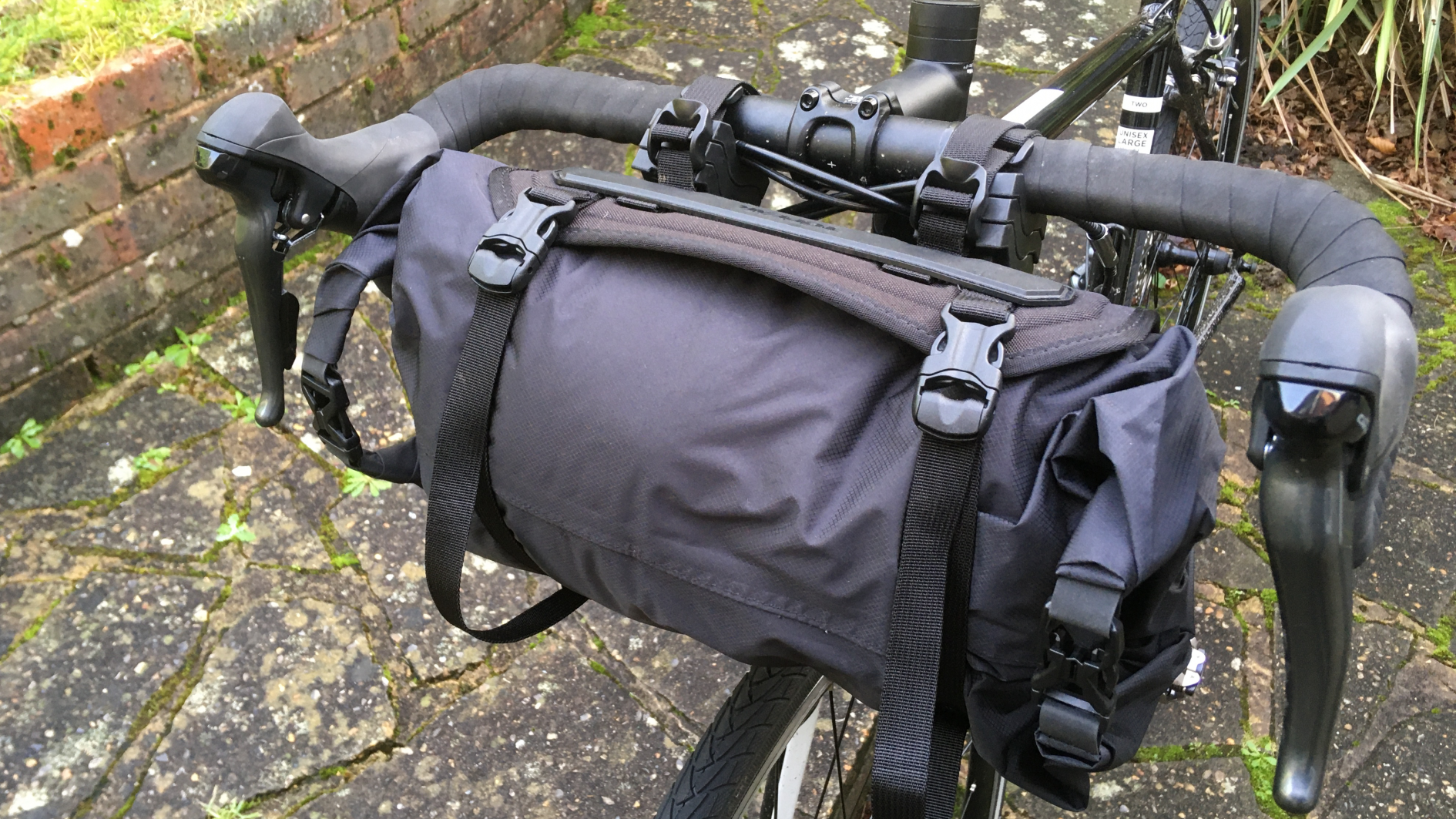
Specifications
Reasons to buy
Reasons to avoid
With an 8-liter capacity, the Topeak Frontloader bag is a good option for light but bulky items like a sleeping bag. There's a harness which can remain attached to the bars and a separate, removable dry bag that opens at each end. An air valve lets you compress the contents down more. The bag and harness combined weigh 500g and will take a maximum 5kg load.
With one sealed pocket, the Frontloader isn't the best bag for access while on the go, but it works well to add plenty of extra carrying capacity. It's stable and doesn't affect the bike's handling, although it can interfere with control cables on some bikes.
Read more: Topeak Frontloader bar bag full review
Best bikepacking handlebar bag for large volume
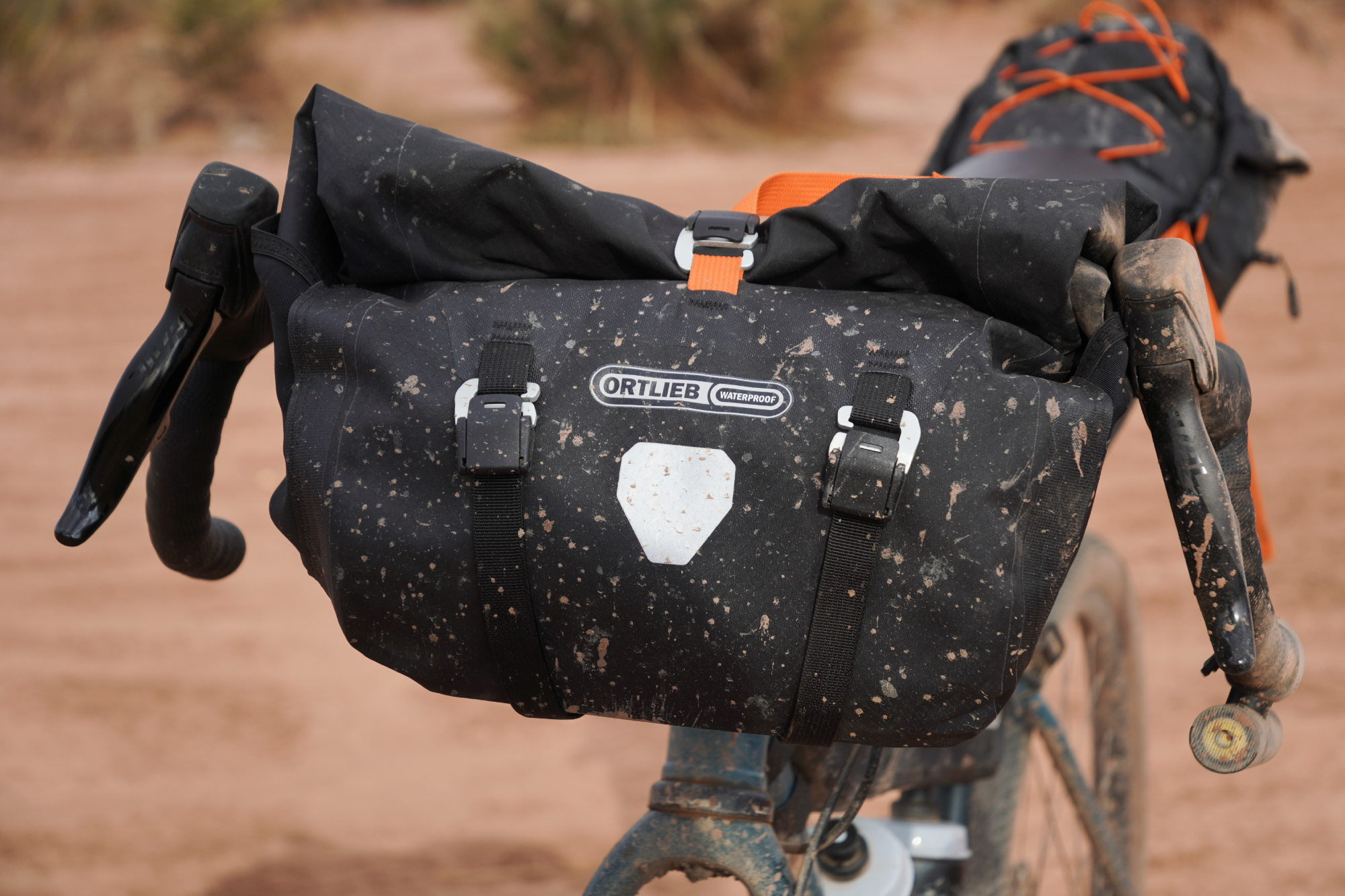
Specifications
Reasons to buy
Reasons to avoid
Rather than the more usual straps or permanent bolt-on support, the Ortlieb bag has a plastic bracket on which the bag hangs. This attaches without tools to the bars, making it easy to remove when not required and preventing the bag from rubbing on the frame.
The 11-liter capacity means that you can pack a lot into the bag, although it's a little wide for drop bar bikes, when the side mesh pockets are really only suitable for gel wrappers. Ideally, you need at least 44cm bar width to take full advantage of the bag's capacity.
Read more: Ortlieb Handlebar Pack QR full review
Top tube bags
Best top tube bag for streamlined space
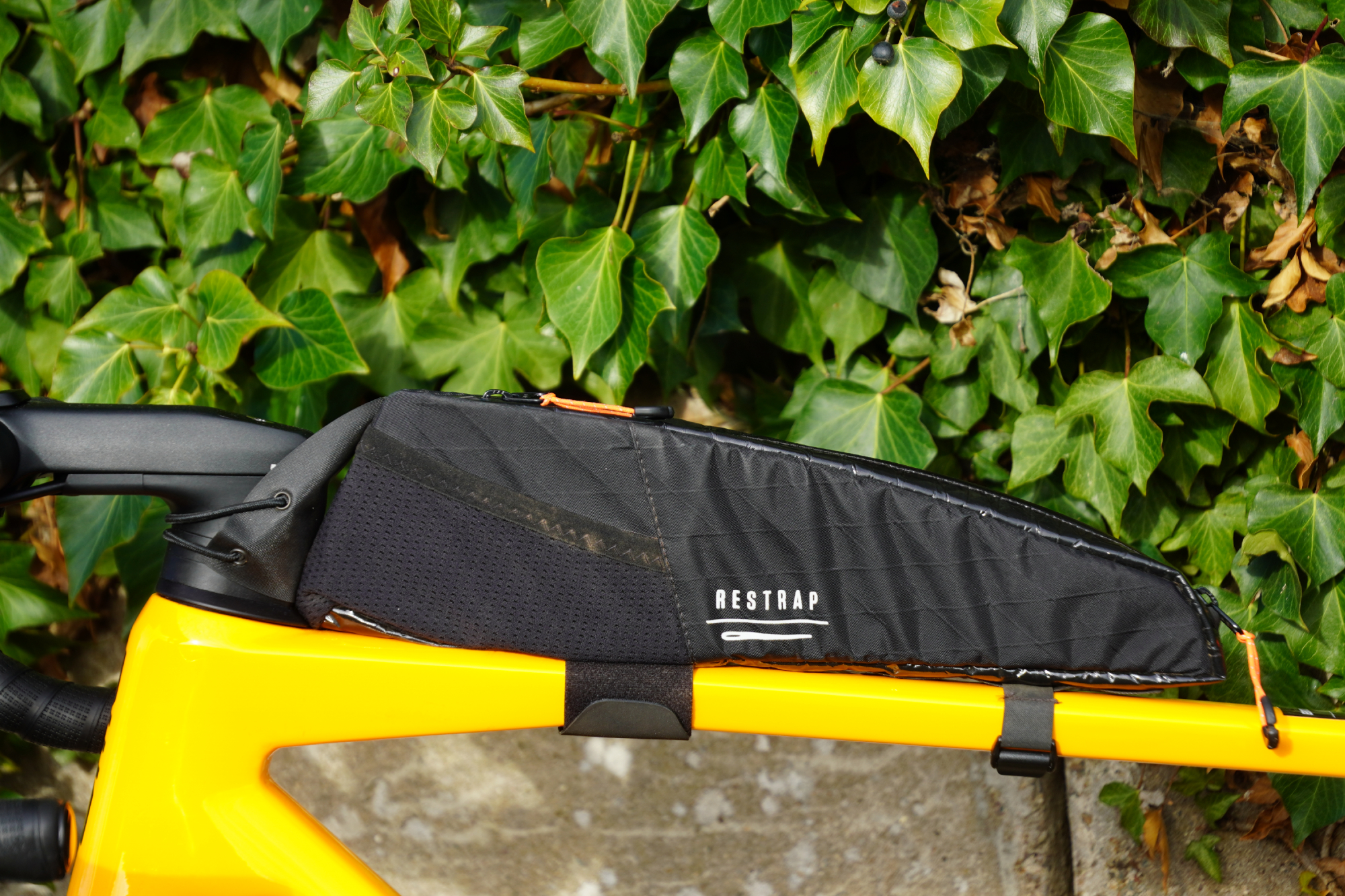
Specifications
Reasons to buy
Reasons to avoid
The 1.5-liter capacity and narrow design of the Restrap Race bag means that it's less likely to interfere with your pedalling, while mesh side pockets let you add extra stowage for items like gels. It is attached to the bike with Velcro straps and a bungee cord.
Waterproofing proved fine for moderate rainfall and the bag feels durable. There's plenty of room for a phone, arm warmers and snacks, although we'd have liked better internal compartmentation.
Read more: Restrap Race Top Tube Bag full review
Best top tube bag for smaller capacity
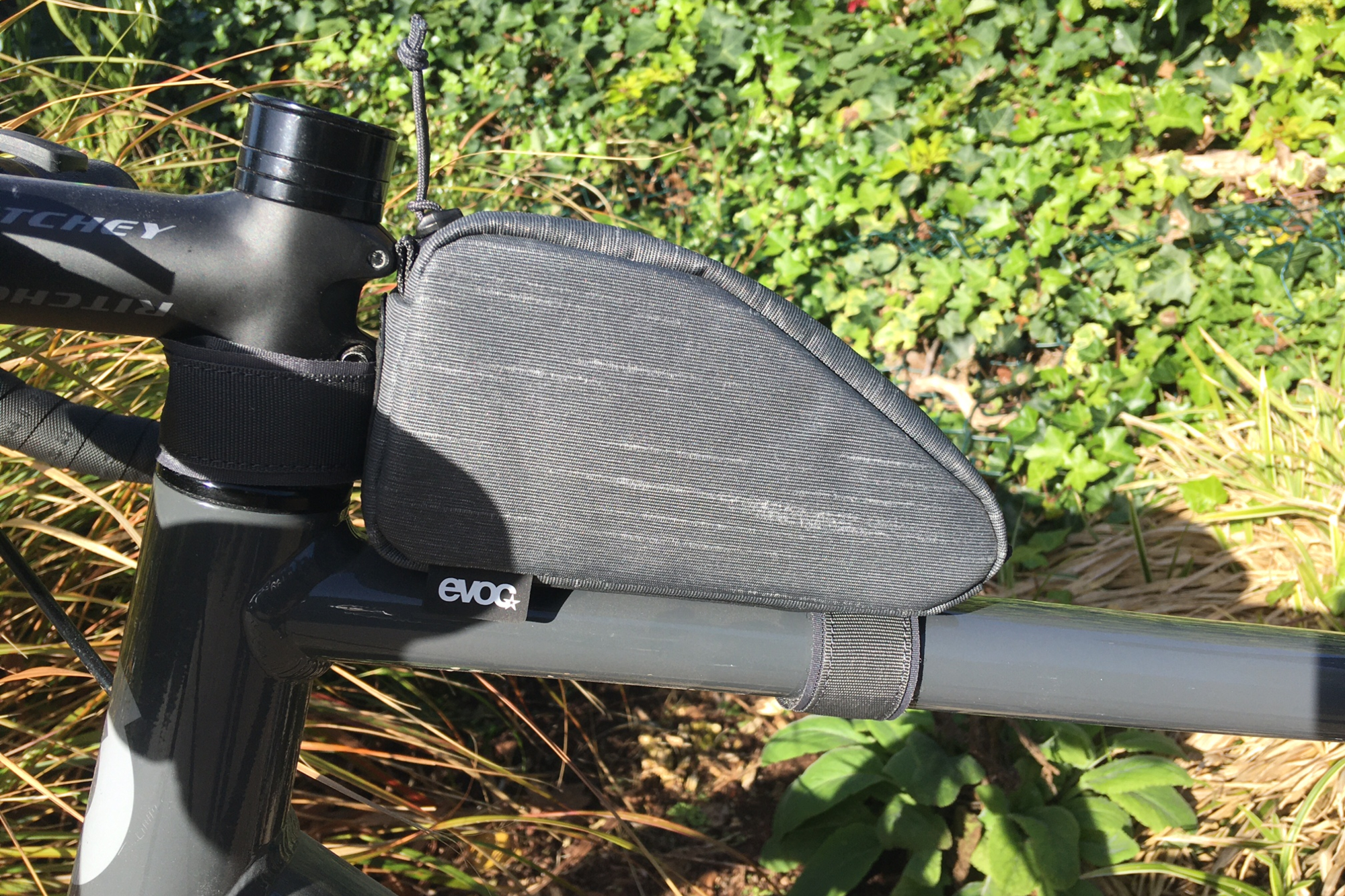
Specifications
Reasons to buy
Reasons to avoid
The Evoc Top Tube Bag provides 0.5 liters of extra carrying capacity for those things you need to get to easily on your ride. Its rigid build means that you can fit heavier items like a (smaller) phone as well as gels and the like. There's a waterproof zip and an internal mesh pocket that helps with organisation.
The bag is easy to attach to the bike via three Velcro straps and remains firmly in place. There's adequate space, it's durable and the Evoc bag isn't expensive for a quality build.
Read more: Evoc Top Tube Pack full review
Best bikepacking frame bag for ease of access
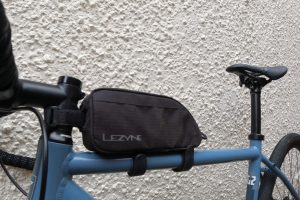
Specifications
Reasons to buy
Reasons to avoid
This useful ride companion is best for those outings where you want to keep heavier items out of your pockets, or simply need to carry more ride essentials. The fabric is robust and water-resistant and the zip is easy to operate on the move.
Attached to the top tube and steerer with Velcro, we found that these straps were a little long on our test bike, so the bag would work best on oversized tubing.
Read more: Lezyne Energy Caddy XL full review
Frame bags
Best bikepacking frame bag serious bikepackers
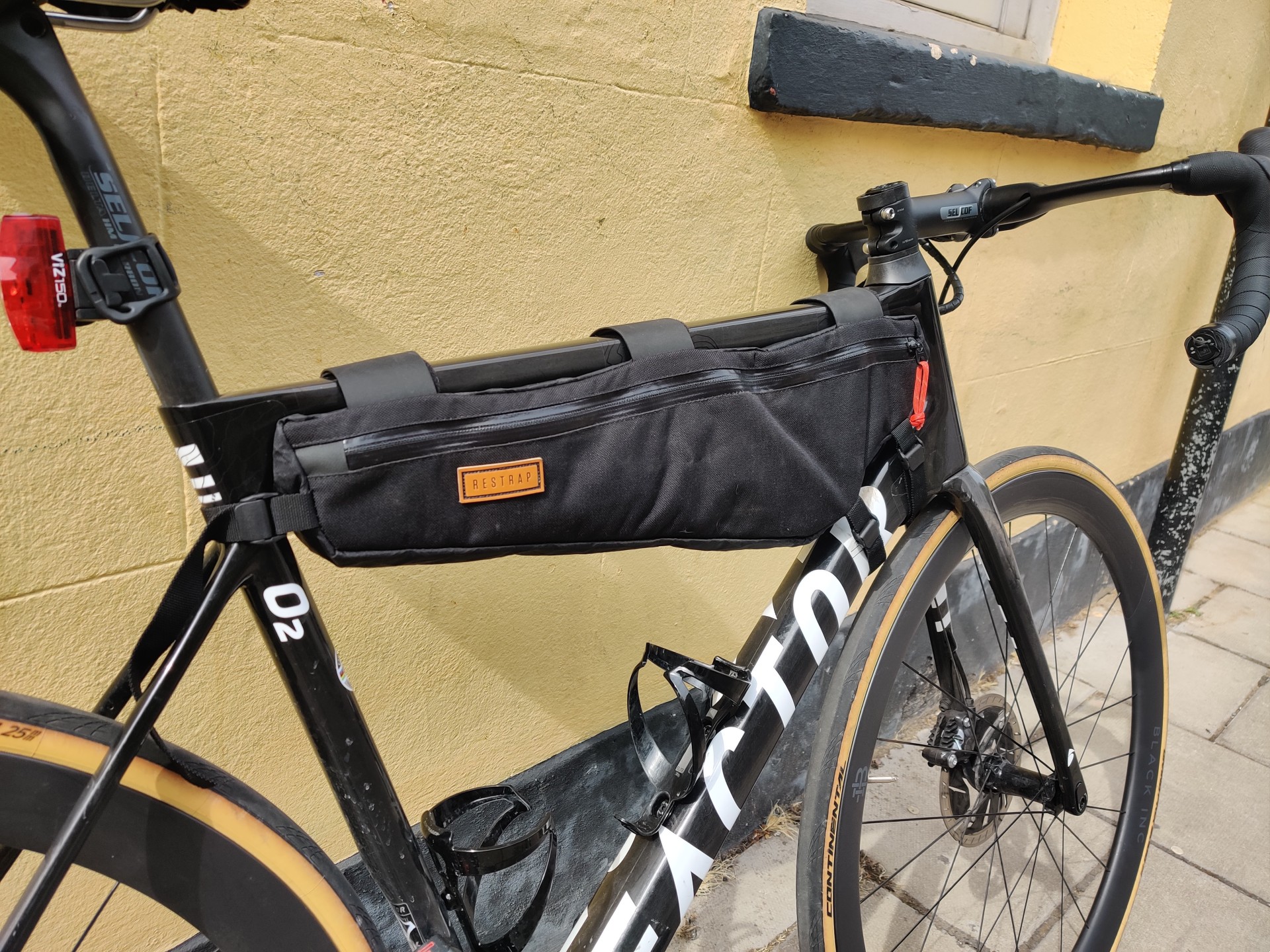
Specifications
Reasons to buy
Reasons to avoid
Restrap offers the Frame Bag in three sizes, with the Large offering 4.5 liters capacity and its 50cm length fitting a size 56 frame perfectly - it should work for a 54 too.
Attachment is via three rubberised Velcro straps on the top tube plus two more on the down tube and a further one on the seat tube, making sure that the bag doesn't move around as you ride. It holds its shape well too and is good for heavier items.
Full-length zips on both sides and a central divider, along with internal pockets help with organisation. It's waterproof, save for some ingress through the cable port on the top of the bag.
Read more: Restrap Frame Bag Large full review
Best bikepacking frame bag for durability
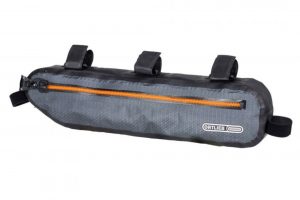
13. Ortlieb Top Tube Frame Pack 4L
Specifications
Reasons to buy
Reasons to avoid
This half-frame bag is designed to make the best use of real estate inside the front triangle without compromising water bottle access. Compatible with anything from carbon road frames to full suspension mountain bikes, it's the ideal place to keep smaller items that you need to access easily, including snacks, electric items and toiletries.
Ortlieb says that the bag is fully waterproof and uses sturdy Velcro straps to attach to the top, head and seat tubes. There's a 3 liter version available as well.
Backpacks
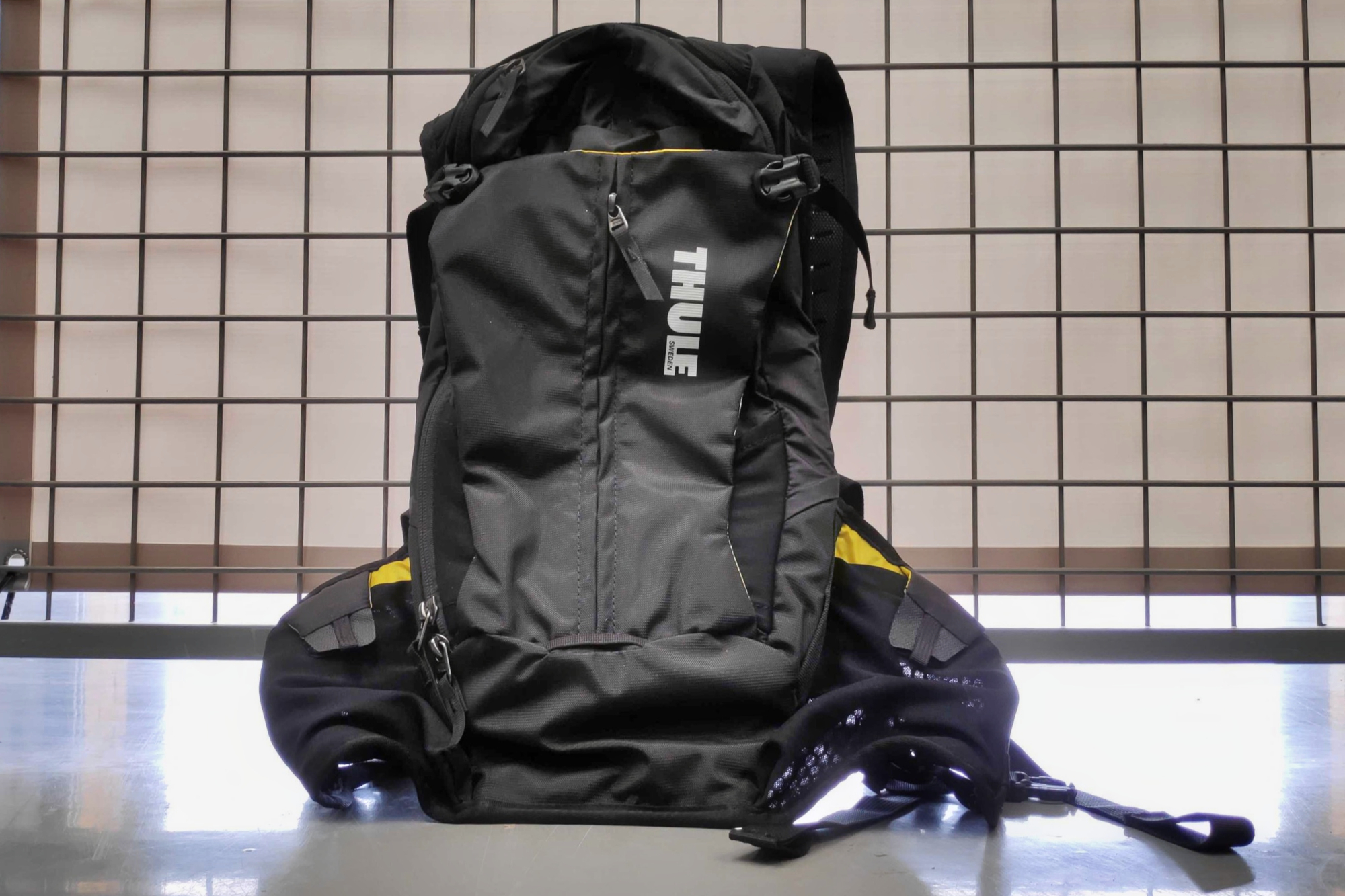
Thule Vital 8 Backpack
Specifications
Reasons to buy
Reasons to avoid
Space in bikepacking bags is always at a premium, so an effective way of adding a little extra capacity is making use of a rucksack. First thing to highlight is the general good advice of letting your bike bear the load rather than your shoulders - heavy kit is still best carried on the bike, and I’ve found going for a smaller sized backpack like this helps to limit the inclination to overpack (and helps stop your kit rattling about so much, too).
There are additional benefits in using a rucksack. I’ve appreciated the convenience of keeping my valuables in the Thule Vital 8, rather than storing them in a top tube bag and having to fish them out and stuff them in my pockets when walking into shops to pick up supplies (and often overstuffing my pockets with those as well!)
Beyond that, by making use of the hydration pack that comes with the Thule Vital 8, that means the space that my water bottles take up can be used by a larger frame bag, which is a more efficient way of using the main triangle of the bike. Of course, you can get this benefit just by using a hydration pack in a full frame bag, but it is easier refilling when the bladder is in your backpack rather than in your frame bag.
The range of pockets and stability when riding with the Thule Vital 8 backpack is great (the latter is somewhat helped by the fact you can’t pack too much into the 8l volume the bag provides). The one downside is that the clip for the stash space (useful for stuffing a windshell or waterproof) has to be undone for you to fully open the main compartment. This adds an extra step and means that the waterproof jacket tends to flop out. It’s frustrating as if the clip was simply on the other side of the zip, neither of those things would be an issue.
Buyers guide to how to choose the best bikepacking bags
Do I need a seat pack for bikepacking trips?
Seat packs are the modern alternative to racks and panniers - but some do feature a lightweight supportive rack. These offer great versatility as you can fit them to almost any bike in a matter of minutes (you'll need to look at specific models if you run a dropper post though).
These seatpost bags typically mount using straps around the seatpost and through the saddle rails. Check that you have plenty of seatpost available for the size of the bag attachment, and smaller riders may find they'll have to opt for a smaller capacity bag here.
Waterproofing varies between models and also has a noticeable impact on cost. Opting for a fully waterproof seat pack (or any bikepacking bag for that matter) will make your life much easier at the end of a long, wet day in the saddle. Alternatively, invest in some good dry bags to pack inside your bags to keep your kit dry.
Often with a generous capacity, a seat pack can be a great place to store bulkier items such as your sleeping bag, clothing and bivvy bag. It may take some time to get used to the feeling of riding with a full seat pack, as your centre of gravity will be raised higher which will affect handling, hence why they are best used for lighter items.
What should I store in a handlebar bag?
Handlebar bags offer great storage capacity at the front of your set-up, both for drop bar and flat bar bikes. For bikepacking trips, the larger bags offer more space, although they're best suited to large and bulky items just like seat packs, as they can be harder to get in and out of quickly.
Mounting-wise, it might take a bit of fiddling to get your dashboard set up just right, especially if you are using a bike computer and lights too. Bar shape will also play a role in system compatibility, although many will work across both straight and drop bar cockpits. However, you will need to consider how they work with the space between the shifters, how much drop there is on your bike from bar to front wheel and your front-end cabling before deciding on capacity.
You might find a handlebar harness is a good alternative for you. This allows you to mount anything from a tent or sleeping bag to a drybag or small duffel bag in front of your bars. Again, like any front bag, you'll need to think about cockpit size, shape and braking, with disc brakes being preferable and cantilever the least compatible.
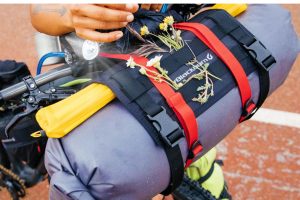
How do I choose a frame bag for bikepacking?
Do I need a full or half-frame bag - and how do I pack it?
Choose between full-frame bags that fit inside the whole front triangle down to the bottom bracket, or smaller half-frame bags that run along the top tube and leave space for your water bottles. If you're going for the first option, you'll need to think about how else to store your water, for example using a bladder and hose system in the frame bag or on your back.
Although frame bags can be a great way to make use of space on the bike for storage, you'll need to carefully check for compatibility. Smaller frames, sloping top tubes and suspension can make fitting tricky, which is why some people opt to go for a custom-made frame bag.
The other important point about frame bags is that you'll need to learn to pack them well. This narrow space doesn't lend itself to bulky items but is better suited to storing flatter kit, thus resulting in the bag bulging less and reducing the possibility of interference with either you and your pedalling or cranks. If using a half-frame bag, this is a great option for small items that you like to keep close to hand, including snacks, electricals, and toiletries.
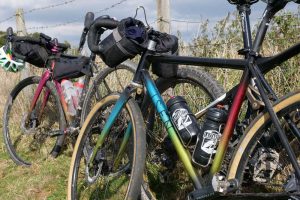
Are there other bags well-suited to bikepacking?
Yes, frame, seat and bar bags aren't the only way for you to carry your gear on a bikepacking trip.
Having a small bag that you can gain easy access to while on the bike can be a game changer in terms of not having to dismount, which is easier said than done when you have a fully laden bike to balance, and you can simply reach in while on the move for food or electrical items.
Snack pouch bags can be very versatile, often with Velcro straps meaning you can fit them to almost any bike. If you don't want to wear anything with pockets on a short blast or you are looking for extra storage on a week-long trip, these little bags can make a big difference.
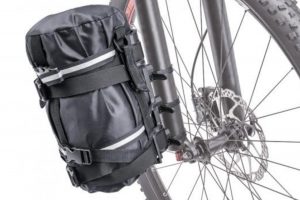
The obvious alternative to bags strapped to your frame is to cantilever them over your wheels in the form of panniers. These will significantly increase your carrying capacity, but that in turn will slow your progress.
If you have a bike intended for touring or bikepacking, you might find the forks come with leg mounts for extra bottle cages, and there are also after-market options that allow you to clamp on additional mounts. These immediately give you increased carrying capacity, either for water or an extra bag.
How we test
Bikepacking bags can only really be assessed by using them extensively; what may be unnoticeable or seem inconsequential at home might turn into a real issue after 3 nights away or 100km into a tough ride. Luckily, Cycling Weekly has a number of keen and experienced bikepackers on hand to put the bags through their paces.
Ease of attachment, stability on the bike and packability are all key considerations for all bikepacking bags, whatever their size. Durability and weatherproofness are also key, as is how the bags interact with the rider in use.
Get The Leadout Newsletter
The latest race content, interviews, features, reviews and expert buying guides, direct to your inbox!

After winning the 2019 National Single-Speed Cross-Country Mountain Biking Championships and claiming the plushie unicorn (true story), Stefan swapped the flat-bars for drop-bars and has never looked back.
Since then, he’s earnt his 2ⁿᵈ cat racing licence in his first season racing as a third, completed the South Downs Double in under 20 hours and Everested in under 12.
But his favourite rides are multiday bikepacking trips, with all the huge amount of cycling tech and long days spent exploring new roads and trails - as well as histories and cultures. Most recently, he’s spent two weeks riding from Budapest into the mountains of Slovakia.
Height: 177cm
Weight: 67–69kg
-
 Save £42 on the same tyres that Mathieu Van de Poel won Paris-Roubaix on, this Easter weekend
Save £42 on the same tyres that Mathieu Van de Poel won Paris-Roubaix on, this Easter weekendDeals Its rare that Pirelli P-Zero Race TLR RS can be found on sale, and certainly not with a whopping 25% discount, grab a pair this weekend before they go...
By Matt Ischt-Barnard
-
 "Like a second skin” - the WYN Republic CdA triathlon suit reviewed
"Like a second skin” - the WYN Republic CdA triathlon suit reviewed$700 is a substantial investment in a Tri Suit, and it is, but you’ll definitely feel fast in it
By Kristin Jenny
-
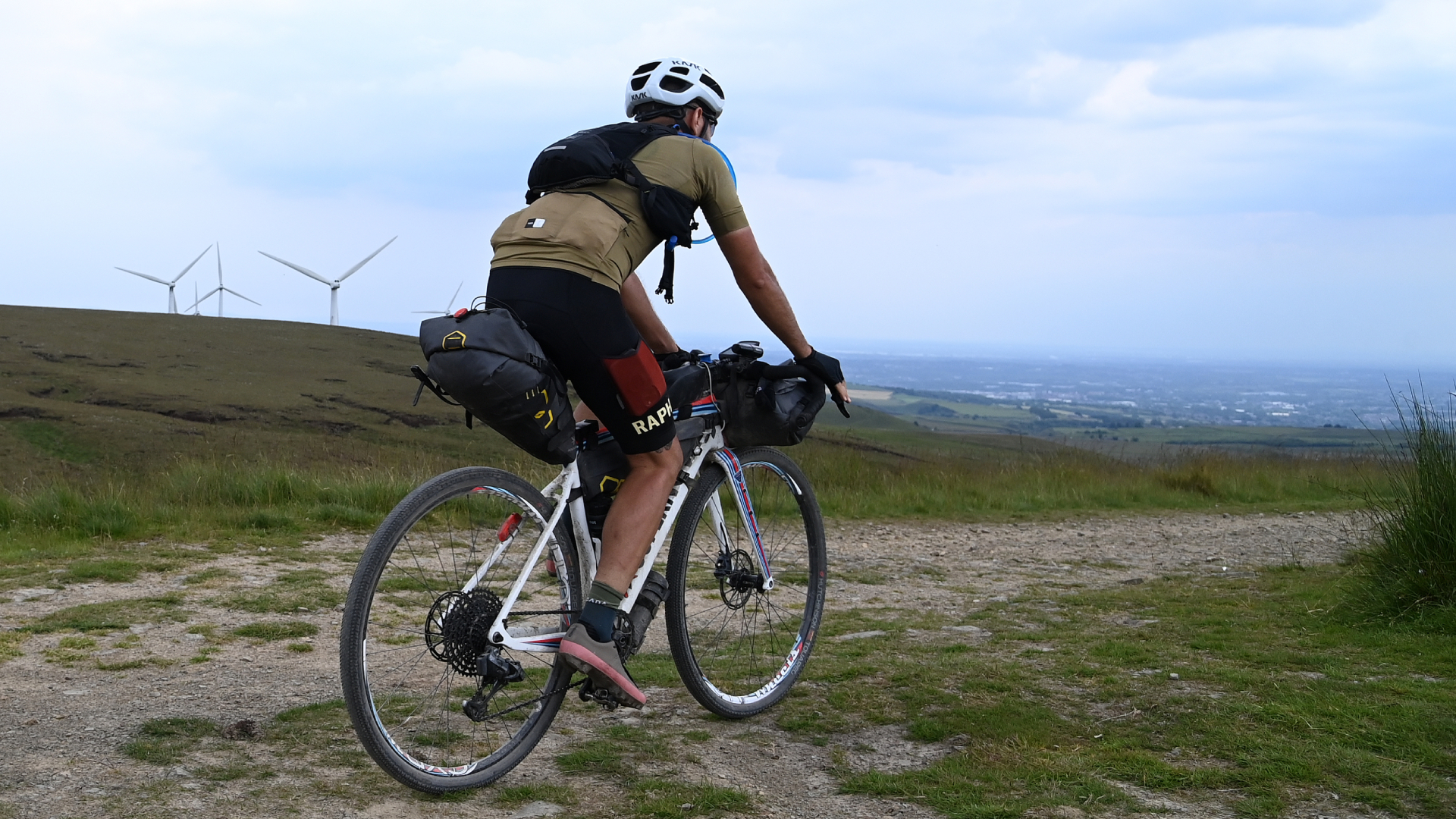 Best cargo bib shorts: extra carrying capacity for your rides
Best cargo bib shorts: extra carrying capacity for your ridesThe best cargo bib shorts will let you stash more items without needing to load up your bike
By Stefan Abram
-
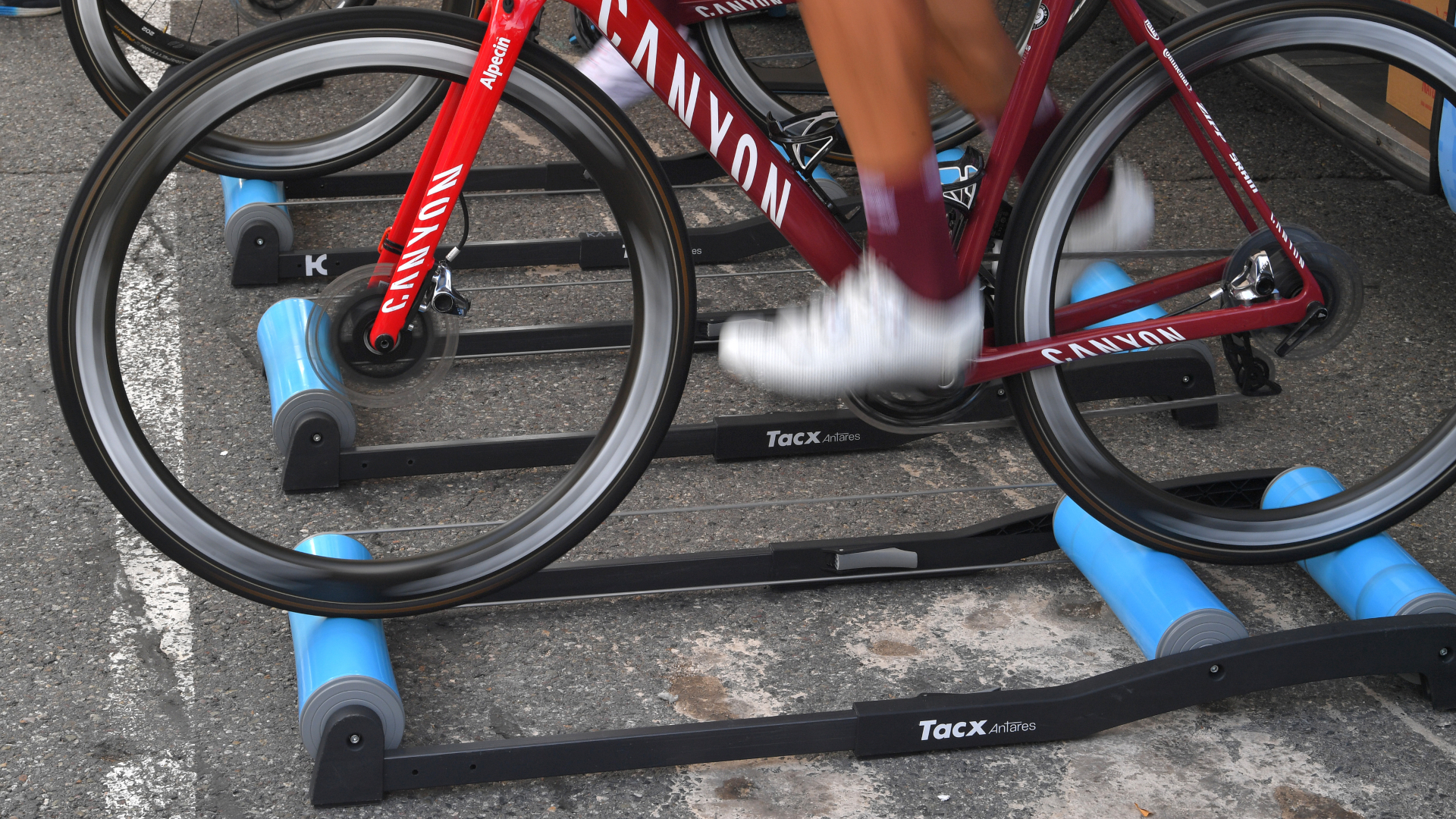 Best bike rollers 2025: add a little spice to your indoor cycling sessions
Best bike rollers 2025: add a little spice to your indoor cycling sessionsHere's our pick of the best bike rollers if you're looking to break up the dreary indoor bike trainer routine with something a little more rocking and rolling
By Michelle Arthurs-Brennan
-
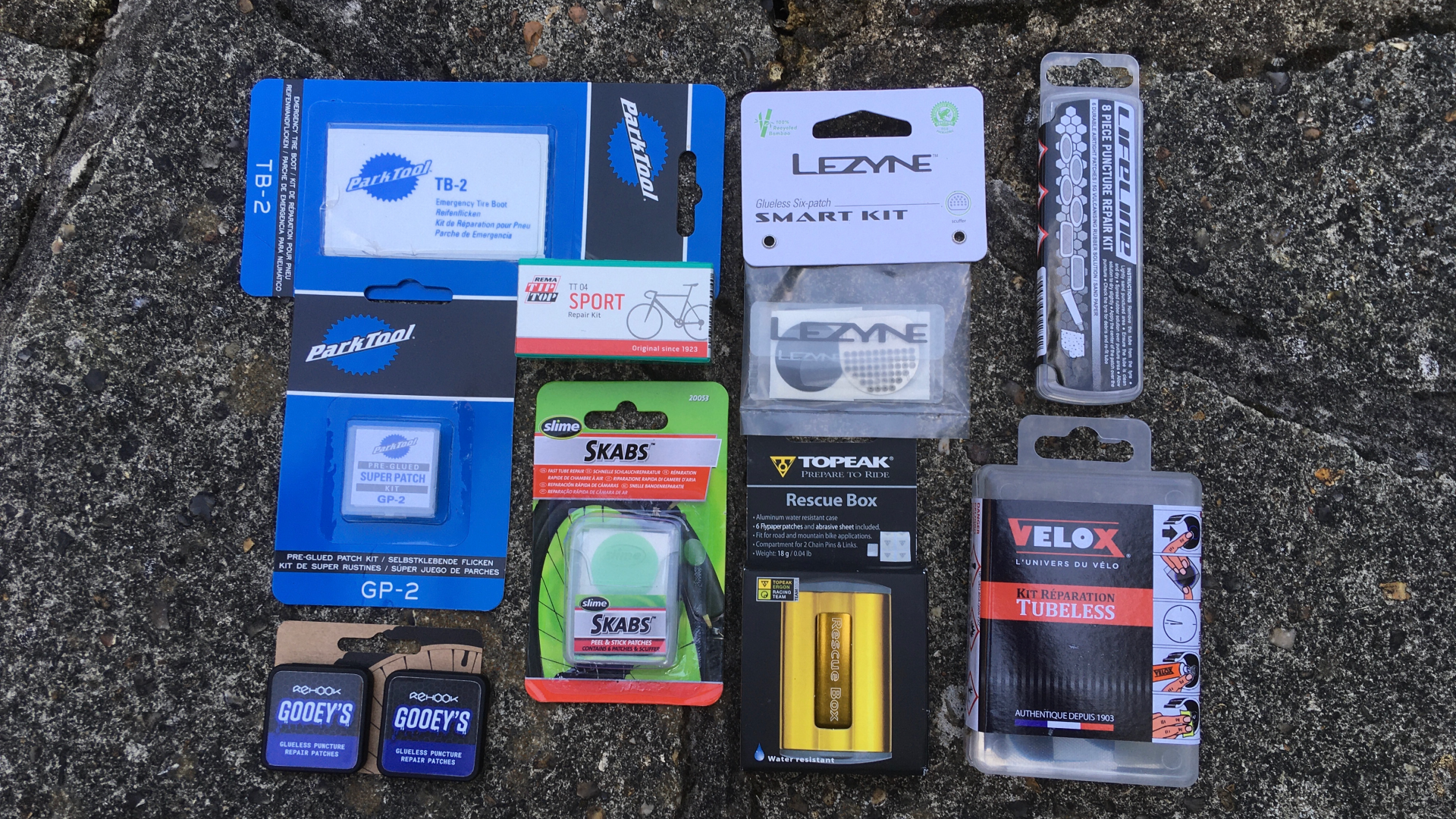 Best puncture repair kits: Don’t waste tubes! Help your wallet and the environment
Best puncture repair kits: Don’t waste tubes! Help your wallet and the environmentGet back on the road as easily as possible with our pick of the best puncture repair kits
By Paul Norman
-
 Best cycling jerseys 2025: our favourite jerseys to ride in every season
Best cycling jerseys 2025: our favourite jerseys to ride in every seasonThe best cycling jerseys should keep you comfortable, whether it's hot, cold or even during an indoor session
By Michelle Arthurs-Brennan
-
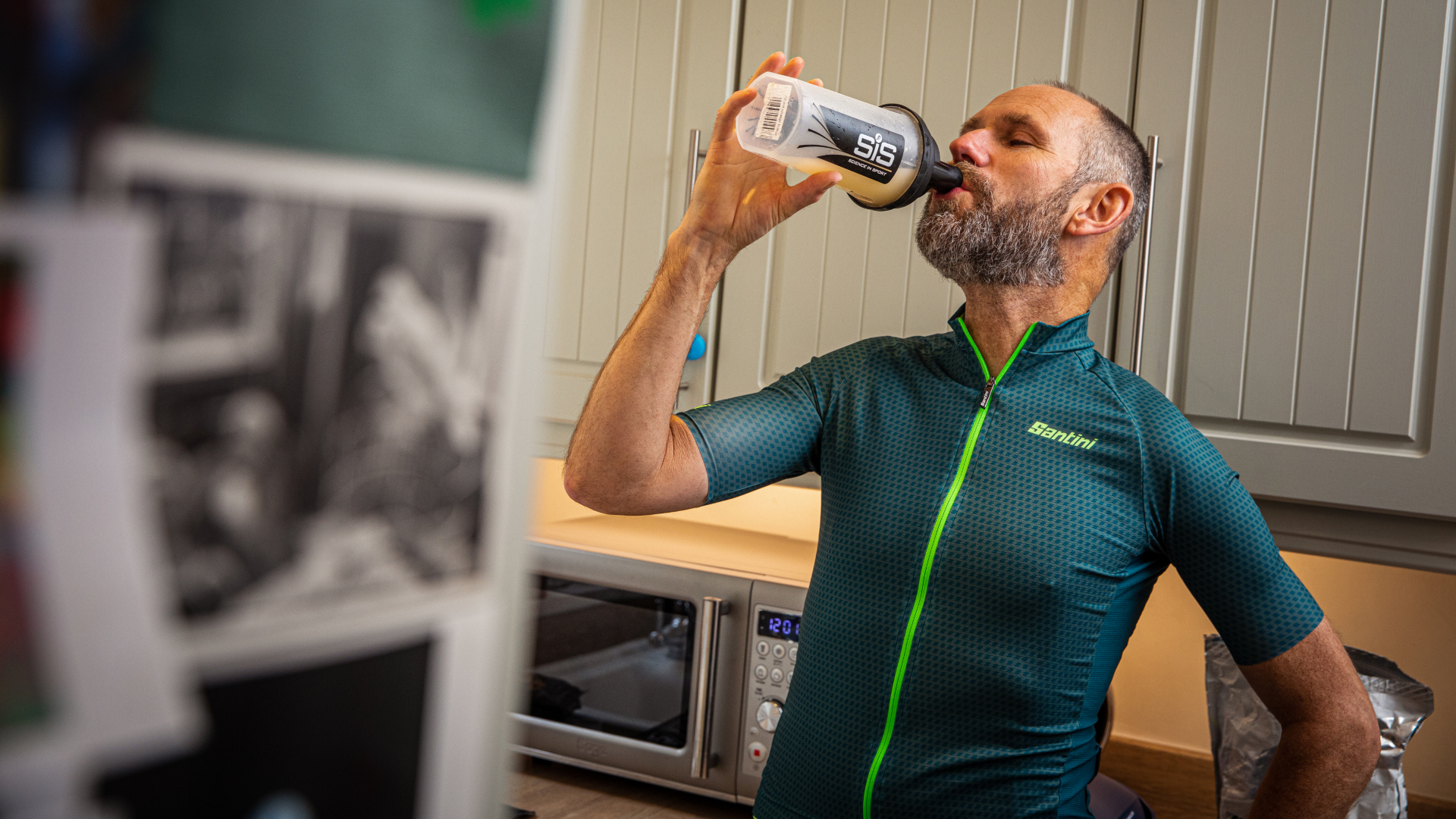 Best recovery drinks for cycling 2025 rated and reviewed
Best recovery drinks for cycling 2025 rated and reviewedWe look at the best available protein and recovery drinks to ensure you’re recovered and good to go for your next training session
By Andy Turner
-
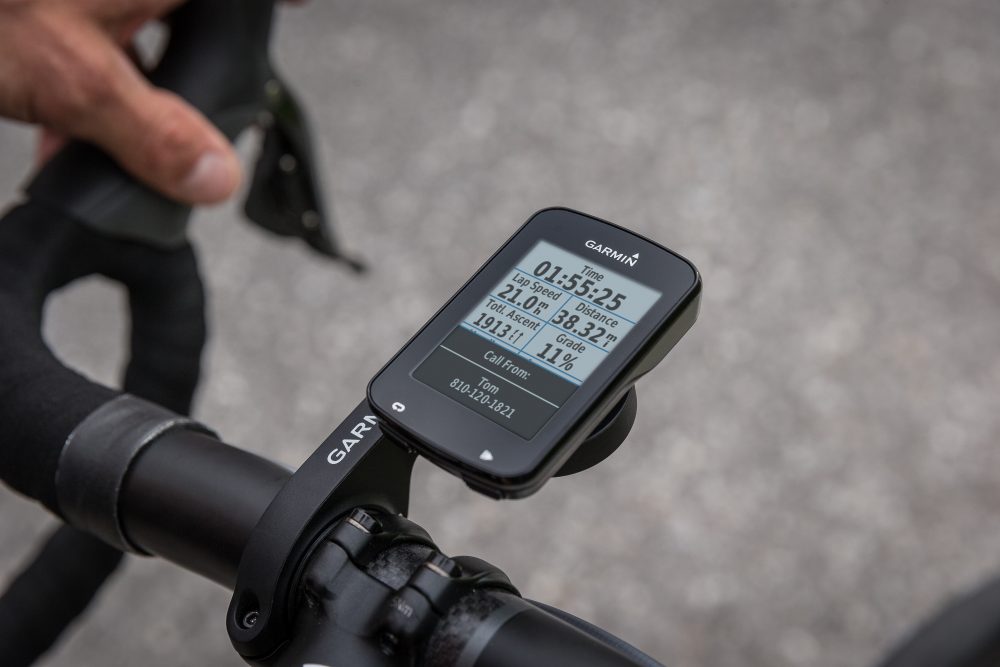 Best Garmin cycling computer: everything you need to know about the range
Best Garmin cycling computer: everything you need to know about the rangeWhether you're looking for a Garmin Edge navigational aid or a computer to push your training, this guide will help you choose the best Garmin Edge for you
By Anna Marie Abram
-
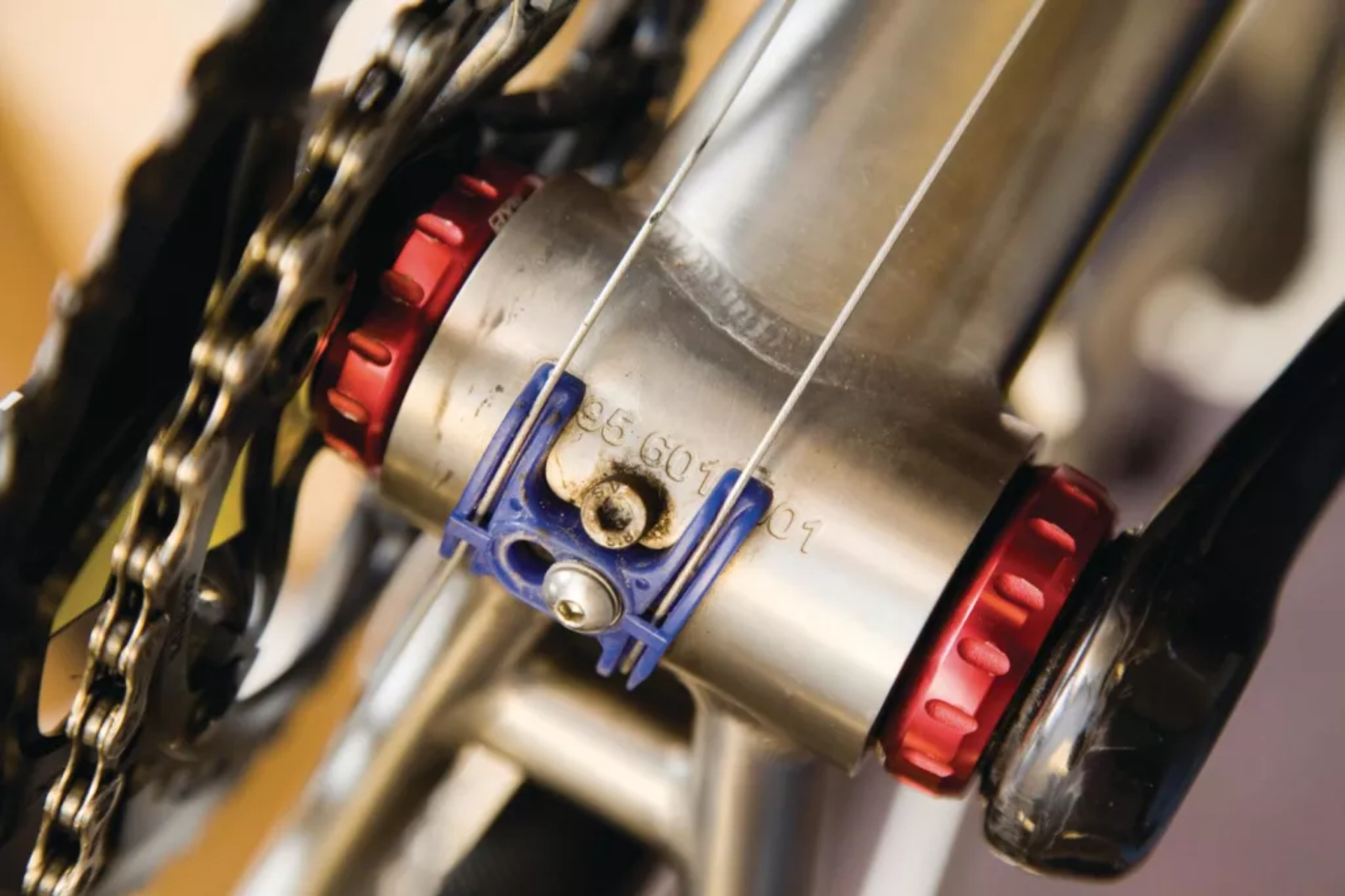 The best bottom bracket for road bikes 2025: stainless steel and ceramic bearing upgrades
The best bottom bracket for road bikes 2025: stainless steel and ceramic bearing upgradesTested and rated aftermarket bottom brackets for staying creak-free and finding extra watts!
By Glen Whittington
-
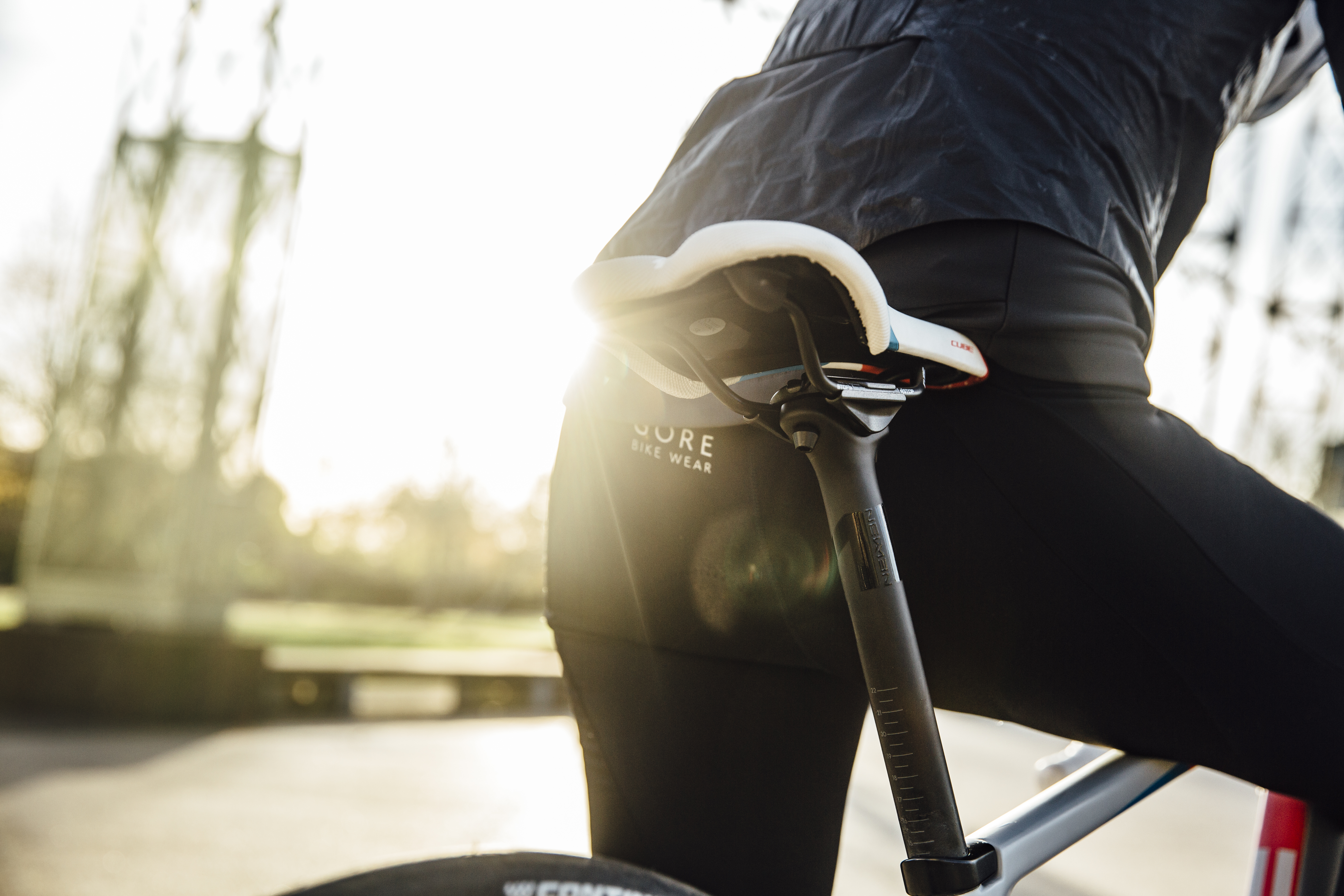 Best women’s bike saddle 2025: six saddles all ridden and rated by female riders
Best women’s bike saddle 2025: six saddles all ridden and rated by female ridersAs one of the few areas where a female-specific product can significantly enhance comfort, here is our guide to the best women's saddles
By Michelle Arthurs-Brennan